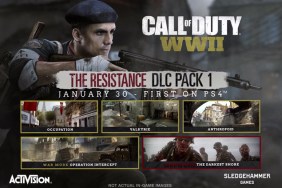With Call of Duty: WWII now out in the wild, you’ve probably already dived into the game’s single-player campaign, which returns to WWII for some gritty, grounded gameplay. Graphically, it’s a treat for the eyes, but aurally, it’s also a treat for the ears.
The man behind that WWII sound is Wilbert Roget II. We interviewed the man behind the music to get a taste of what’s involved in composing for one of the biggest games of the year.

Crave: Tell me about how you got involved with Call of Duty. How has the experience been for you?
Wilbert Roget II: Working on Call of Duty: WWII has been an incredible experience – partly because this is a franchise I’ve admired since college, partly because I collaborated with legendary audio and music teams, and of course, the return to the World War II setting made it even more special. Having such an experienced team of collaborators helped tremendously, giving me the freedom to experiment and attempt to create a soundtrack worthy of the title.
How has the franchise’s return to World War II affected your approach to scoring? Were there any demands placed on you to ensure that this sounded “different” to the recent futuristic Call of Duty games?
When I began scoring, my first sketches could be described as a mix of the original Michael Giacchino Call of Duty sound, the Advanced Warfare sound, and a tad more Erich Korngold / John Williams sound. But I was scoring too closely to the setting initially, and we quickly realized that we needed a grittier, less conventionally “epic”, and more personal treatment for this title. This was a work of historical fiction, but more importantly it was a character story about very real people – not super soldiers.
So my solution was to embrace a musical simplicity and clarity, stripping out overt uses of synthesizer and overly elaborate orchestration and instead relying on simpler harmonies, driving rhythms, “musique concrète” sounds based on vehicles from the era, and melodic themes that develop throughout the score. I created signature sounds such as the “haze of war” effect and the “memory of war” concept, both of which can be heard in the first several seconds of the main theme, and used these ideas in almost every music cue. And lastly, I used string quartet and solo strings extensively during action cues to get even tighter, grittier and more in-your-face rhythms.
It’s been nine years since the last Call of Duty set in World War II. Did you go back and listen to the score of World at War? How does the music in WWII differ?
I actually wasn’t as familiar with the World at War sound as I was with the original Call of Duty sound, at the time that I was writing Call of Duty: WWII. I employed unusual orchestral playing techniques quite frequently in the Call of Duty: WWII score, as well as extensive sound design. But in our case, again, we had a very personal and character-driven story, and so our score differs in some of the approaches and musical choices. For example, I avoided using snare drums or melodic trumpets, as that would suggest too much of an epic storytelling vibe rather than an up close and personal, relatable feeling.
You’ll no doubt want to both respect the tragedies that occurred at the time, while also making the player feel excited and powerful. How difficult is it to strike a balance that works?
This was one of the challenges of writing the score, initially. You’ll notice, for example, that there really isn’t any action music in John Williams’ Saving Private Ryan score – these scenes were entirely focused on the sound design, to capture as much of the realism and horror of battle as possible. On Call of Duty: WWII we had two opposing forces: we needed to respect the setting and its realistic portrayal, but at the same time, the necessities of the gameplay called for action music.
My solution was twofold: First, as I mentioned before, I tried to make my music as focused and clear as possible, without too much orchestral embellishment or overt use of synthesizers or percussion. Gritty staccato solo strings gave us driving rhythm in several action cues, where other scores might use pulsing synths or epic percussion.
The other technique I used was to allow for moments of “space” in the action cues. Combat music is rarely high-intensity for the entire piece, but instead I’ll often segue into a few measures of suspenseful tension here and there, to focus on my musique concrète sound design elements.
Do you begin scoring the first level and make your way through the game chronologically? Or is there a different method to the music you create?
I’ve written some scores chronologically, but for Call of Duty: WWII, we had a more nuanced process that involved the Sony Interactive Entertainment music team as our music supervisors and editors. I certainly began with the main theme, but after that, we worked extensively with the Sony team to identify what types of pieces would be needed. Instead of asking for “music for level two”, they’d spot the game’s levels, giving a general description of what each piece should sound like. Then as the score went on and more melodies and themes were developed, I’d get additional, more refined requests. Finally, when music was recorded and mixed, they would edit the pieces to fit the levels more specifically, creating new cues out of elements from our recordings. It was a wonderfully fluid way to work, and ensured that the game always had the correct variety of music.
Give the Call of Duty: WWII soundtrack a listen on SoundCloud (preview) or iTunes (for the full experience).







